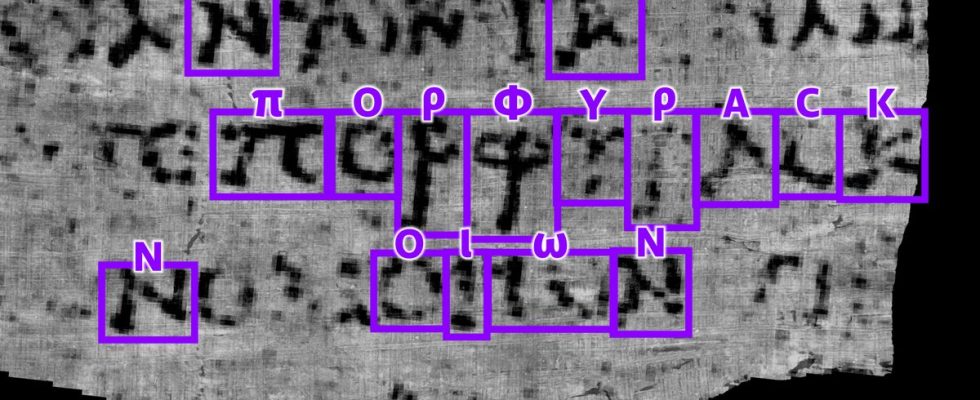21-year-old student manages to decipher word on 2,000-year-old charred papyrus
We have been trying to make people talk for centuries these parchments from Greco-Roman antiquity made illegible by the eruption of Vesuvius in the year 79. The famous eruption that buried Pompeii in ashes also devastated the nearby city of Herculaneum. In the 17th century, nearly 700 rolls of parchment were found in the remains of a villa in this city. Cooked by the volcano’s lava, they had become black as coal and extremely crumbly.
Each time an attempt was made to unroll one of these scrolls to read it, it disintegrated into tiny fragments and its contents were lost forever. But a few years ago, researchers have managed to virtually unroll some of these papyri. They have, as it were, x-rayed the inside of the rollers. On the very gray images obtained, we could distinguish tiny differences in texture linked to the ink but there was nothing immediately readable. That’s when the idea of creating the Vesuvius Challenge was born.
Objective of this challenge: Make these images speak using artificial intelligence. There are different amounts to be won depending on the number of words deciphered. Up to $700,000 to the person who can read at least 4 passages from a parchment.
Luke Farritor, a computer science student from Nebraska, got involved. He developed a machine learning algorithm. His program made it possible to decipher around twenty letters including a series which forms the word “porphyras” which means purple in Greek.. For this discovery, the 21-year-old young man pocketed $40,000. By improving its program we could bring hundreds of texts over 2000 years old out of oblivion. There are certainly nuggets in this Greco-Roman library, the only one from this period to have reached us.
To find out more: the website Vesuvius Challenge and an article from Science and the future
An exceptional solar flare left traces in tree stumps 14,300 years ago
The sun sometimes projects bursts of electrically charged particles towards the Earth. Upon entering the atmosphere, these particles generate the Northern Lights. These solar flares are relatively frequent but the one that interests us was extraordinary! The most intense ever recorded to date. It occurred 14,300 years ago and was recorded by Scots pines in the Southern Alps whose strains were preserved in the alluvium of a river.
Scientists discovered that one of the growth rings of these strains had an abnormally high proportion of carbon-14. This reveals that at the time of this ring’s formation, there were 5 times more of these particular carbon atoms in the atmosphere than usual. This anomaly is the signature of a colossal solar flare. She must have generated spectacular northern lights visible from France. If such a phenomenon occurred today it would also cause a widespread failure of our satellites. which would not withstand a solar storm of such magnitude.
To find out more: scientific publication and an article in the newspaper The world
The surprising strategy of female frogs to dissuade males from mating with them
For many amphibians, reproduction is a combat sport. The males throw themselves frenziedly on the females, sometimes in groups. It even happens that females die drowned under the attacks of overexcited males..
Researchers have just discovered that the female common frog had developed an effective display to ward off undesirables. She plays dead. She stops and tenses. And she plays the comedy well enough for the annoying people to turn around. We will still remember that there is still a way to go before male frogs transform into princes charming.
To find out more: The scientific publication and an article from International mail

